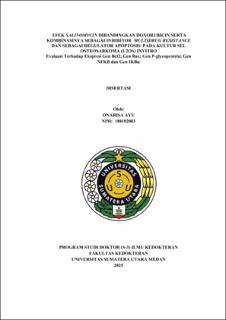| dc.contributor.advisor | Rusda, Muhammad | |
| dc.contributor.advisor | Sembiring, Rosita Juwita | |
| dc.contributor.advisor | Nasution, Iqbal Pahlevi Adeputra | |
| dc.contributor.author | Ayu, Onarisa | |
| dc.date.accessioned | 2025-09-23T04:05:19Z | |
| dc.date.available | 2025-09-23T04:05:19Z | |
| dc.date.issued | 2025 | |
| dc.identifier.uri | https://repositori.usu.ac.id/handle/123456789/108565 | |
| dc.description.abstract | Background: Osteosarcoma is a primary bone malignancy often resistant to
chemotherapy, primarily due to overexpression of P-glycoprotein (Pgp). This study
aims to evaluate the effects of salinomycin, compared to doxorubicin and their
combination, on apoptosis regulation and multidrug resistance gene expression in
U2OS osteosarcoma cells in vitro.
Methods: A true in vitro experimental study was conducted using six groups:
control, doxorubicin, three salinomycin doses, and a combination group. Cell
viability (MTT assay) and gene expression of Bax, Bcl2, Pgp, NF-κB, and IκBα
were assessed via qRT-PCR.
Results: MTT assay revealed that the IC50 value of salinomycin was 0.0125 μM,
while that of doxorubicin was 0.1 μg/mL. Salinomycin significantly reduced cell
viability, particularly at a dose of 0.025 μM. The combination of salinomycin and
doxorubicin resulted in the highest expression of the pro-apoptotic gene Bax (4.16-
fold), whereas the lowest expression of the anti-apoptotic gene Bcl2 was observed
at 0.005 μM salinomycin (0.61-fold). The combination therapy also showed a
reduction in P-glycoprotein expression (0.47-fold), indicating an effect on
multidrug resistance. In addition, the lowest NF-κB expression was found at 0.005
μM salinomycin, while the highest IκBα expression was observed at 0.025 μM
salinomycin. These findings suggest that salinomycin acts by suppressing the NF-
κB pathway and enhancing apoptosis.
Conclusion: Salinomycin exhibits potential as a multidrug resistance inhibitor by
modulating the NF-κB pathway and suppressing Pgp expression. When combined
with doxorubicin, it enhances apoptotic signaling, suggesting its role as a
promising adjuvant therapy for chemoresistant osteosarcoma. | en_US |
| dc.language.iso | id | en_US |
| dc.publisher | Universitas Sumatera Utara | en_US |
| dc.subject | Salinomycin | en_US |
| dc.subject | Doxorubicin | en_US |
| dc.subject | Apoptosis | en_US |
| dc.subject | Osteosarcoma | en_US |
| dc.subject | Multidrug resistance | en_US |
| dc.title | Efek Salinomycin Dibandingkan Doxorubicin serta Kombinasinya sebagai Inhibitor Multidrug Resistance dan Sebagai Regulator Apoptosis pada Kultur Sel Osteosarkoma (U2OS) Invitro: Evaluasi Terhadap Ekspresi Gen Bcl2, Gen Bax, Gen P-glycoprotein, NF-κB, dan IκBα | en_US |
| dc.title.alternative | The Effects of Salinomycin Compared with Doxorubicin and Their Combination as Multidrug Resistance Inhibitors and Regulators of Apoptosis in Osteosarcoma (U2OS) Cell Culture In Vitro: Evaluation of Bcl-2, Bax, P-glycoprotein, NF-κB, and IκBα Gene Expression | en_US |
| dc.type | Thesis | en_US |
| dc.identifier.nim | NIM188102003 | |
| dc.identifier.nidn | NIDN0020056802 | |
| dc.identifier.nidn | NIDN0021077308 | |
| dc.identifier.kodeprodi | KODEPRODI11001#Ilmu Kedokteran | |
| dc.description.pages | 167 Pages | en_US |
| dc.description.type | Disertasi Doktor | en_US |
| dc.subject.sdgs | SDGs 3. Good Health And Well Being | en_US |


